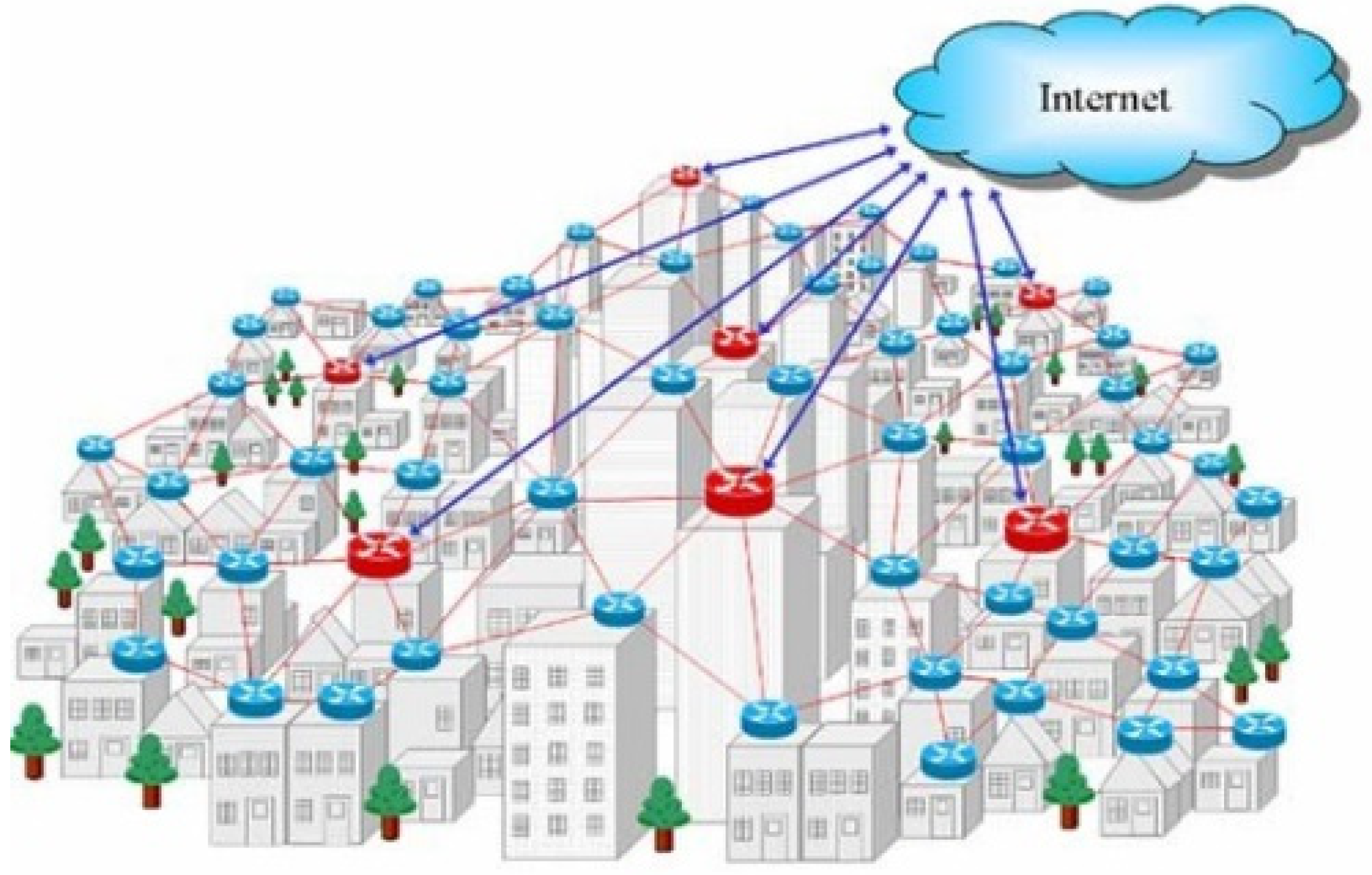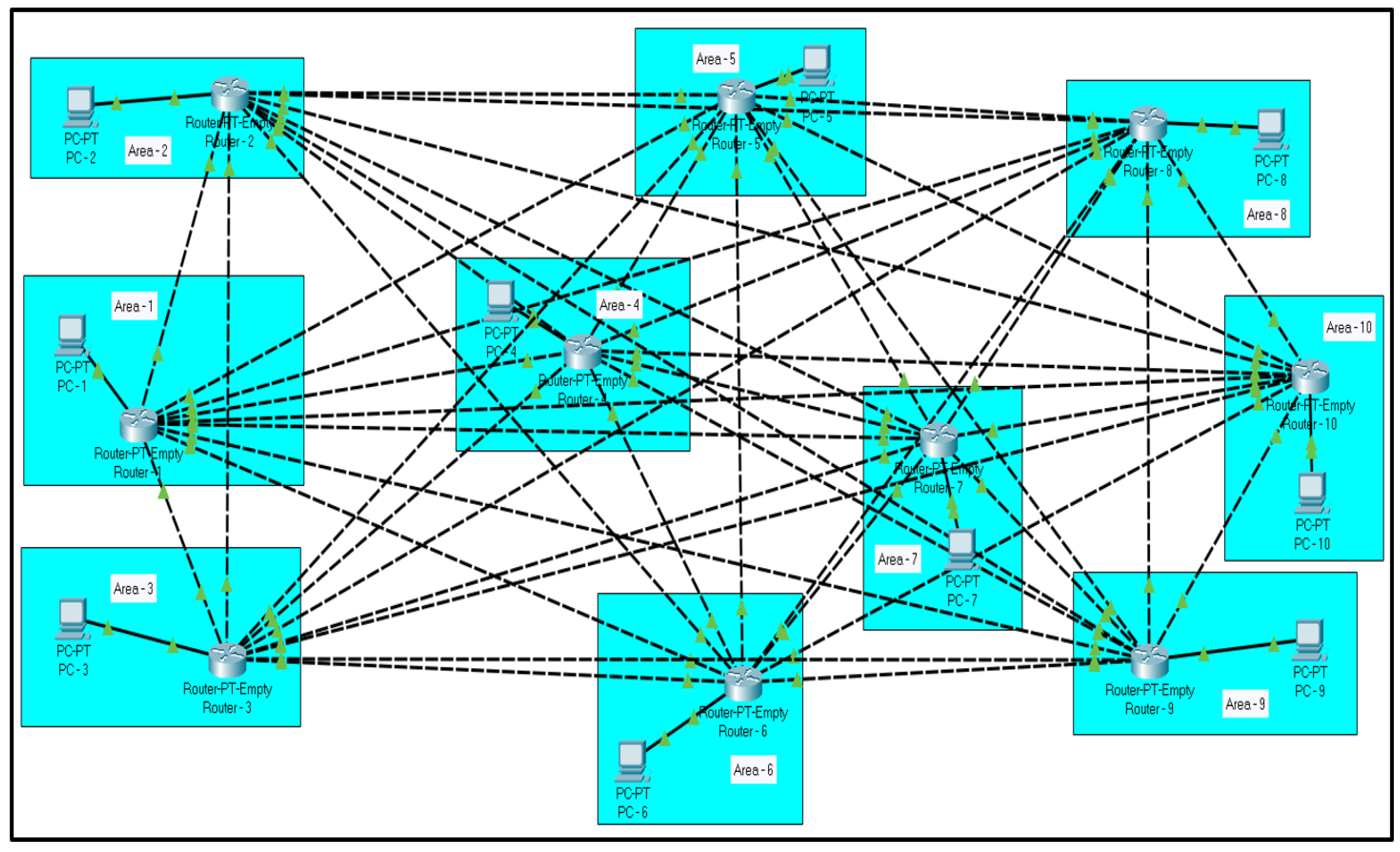Performance Analysis of Mesh Based Enterprise Network Using RIP, EIGRP and OSPF Routing Protocols †
Abstract
:1. Introduction
2. Concept of the Mesh Based Enterprise Wireless Sensor Network
3. Problem Description and Main Contribution
- ✓
- These steps are used to receive and send network information.
- ✓
- Second, finding the best route to a location and adding it to the routing database.
- ✓
- Finally, it is a procedure to identifying, responding and notifying network changes.
- ✓
- To create two network topologies with RIP, EIGRP and OSPF to analyze their performance.
- ✓
- To simulate various network topologies using packets, transfer and observe the performance differences between the OSPF, EIGRP and RIP networks.
- ✓
- Summarize and analyze the simulated findings.
4. Scenario Analysis
5. Time Testing
6. Analysis Results
7. Conclusions
Author Contributions
Funding
Institutional Review Board Statement
Informed Consent Statement
Data Availability Statement
Conflicts of Interest
References
- Shabbir, N.; Hassan, S.R. Routing Protocols for Wireless Sensor Networks (WSNs). In Wireless Sensor Networks—Insights and Innovations; Sallis, P., Ed.; IntechOpen: Rijeka, Croatia, 2017. [Google Scholar]
- Mahmood, A. Performance Analysis of Routing Protocols RIP, EIGRP, OSPF and IGRP using Networks connector. In Proceedings of the 1st International Multi-Disciplinary Conference Theme: Sustainable Development and Smart Planning, IMDC-SDSP 2020, Cyperspace, 28–30 June 2020. [Google Scholar]
- Dey, G.K.; Ahmed, M.M.; Ahmmed, K.T. Performance analysis and redistribution among RIPv2, EIGRP & OSPF Routing Protocol. In Proceedings of the 2015 International Conference on Computer and Information Engineering (ICCIE), Rajshahi, Bangladesh, 26–27 November 2015; pp. 21–24. [Google Scholar]
- Fiade, A.; Agustian, M.A.; Masruroh, S.U. Analysis of Failover Link System Performance in OSPF, EIGRP, RIPV2 Routing Protocol with BGP. In Proceedings of the 7th International Conference on Cyber and IT Service Management (CITSM), Jakarta, Indonesia, 6–8 November 2019; pp. 1–7. [Google Scholar]
- Putri, H.K.; Yovita, L.V.; Negara, R.M. Performance analysis of CSIT routing in a delay tolerant networks. In Proceedings of the 2017 4th International Conference on Electrical Engineering, Computer Science and Informatics (EECSI), Yogyakarta, Indonesia, 19–21 September 2017; pp. 1–6. [Google Scholar]
- Dumitrache, C.G.; Predusca, G.; Circiumarescu, L.D.; Angelescu, N.; Puchianu, D.C. Comparative study of RIP, OSPF and EIGRP protocols using Cisco Packet Tracer. In Proceedings of the 5th International Symposium on Electrical and Electronics Engineering (ISEEE), Galati, Romania, 20–22 October 2017; pp. 1–6. [Google Scholar]
- Biradar, A.G. A Comparative Study on Routing Protocols: RIP, OSPF and EIGRP and Their Analysis Using GNS-3. In Proceedings of the 2020 5th IEEE International Conference on Recent Advances and Innovations in Engineering (ICRAIE), Jaipur, India, 1–3 December 2020; pp. 1–5. [Google Scholar]
- Narasimha, K.; Bramarambika, P.; Santosh, V.S.; Reddy, M.V.; Kumar, S. Network Design and Implementation of Dynamic Routing Protocols Using Packet Tracer. In Proceedings of the 2020 International Conference on Smart Technologies in Computing, Electrical and Electronics (ICSTCEE), Bengaluru, India, 9–10 October 2020; pp. 366–370. [Google Scholar]
- Nedyalkov, I.; Stefanov, A.; Apostolov, P. Modeling of the convergence time of an IP-based network with different traffic loads. In Proceedings of the IEEE EUROCON 2019—18th International Conference on Smart Technologies, Novi Sad, Serbia, 1–4 July 2019; pp. 1–6. [Google Scholar]
- Nastase, A.; Predusca, G.; Puchianu, D.; Circiumarescu, L.; Angelescu, N. Simulation Based of Comparative Study of Routing Protocols for Real Time Applications. In Proceedings of the 2019 22nd International Conference on Control Systems and Computer Science (CSCS), Bucharest, Romania, 28–30 May 2019; pp. 531–535. [Google Scholar]
- Nedyalkov, I. Studying of a Modeled IP–Based Network Using Different Dynamic Routing Protocols. In Proceedings of the 2019 X National Conference with International Participation (ELECTRONICA), Sofia, Bulgaria, 16–17 May 2019; pp. 1–4. [Google Scholar]
- Alam, T.; Refat, C.M.M.; Imran, A.Z.M.; Rashid, S.Z.; Kabir, M.H.; Tarek, R.H.; Gafur, A. Design and Implementation of a Secured Enterprise Network using Dynamic Multipoint VPN with HSRP Protocol. In Proceedings of the 2018 International Conference on Innovations in Science, Engineering and Technology (ICISET), Chittagong, Bangladesh, 27–28 October 2018; pp. 367–371. [Google Scholar]
- Sabbir, M.M.H.; Islam, M.T.; Rashid, S.Z.; Gafur, A.; Kabir, M.H. An Approach to Performance and Qualitative Analysis of Routing Protocols on IPv6. In Proceedings of the 2019 International Conference on Electrical, Computer and Communication Engineering (ECCE), Cox’sBazar, Bangladesh, 7–9 February 2019; pp. 1–6. [Google Scholar]
- Masruroh, S.U.; Widya, K.H.P.; Fiade, A.; Julia, I.R. Performance Evaluation DMVPN Using Routing Protocol RIP, OSPF, And EIGRP. In Proceedings of the 2018 6th International Conference on Cyber and IT Service Management (CITSM), Parapat, Indonesia, 7–9 August 2018; pp. 1–6. [Google Scholar]
- Karna, H.; Baggan, V.; Sahoo, A.K.; Sarangi, P.K. Performance Analysis of Interior Gateway Protocols (IGPs) using GNS-3. In Proceedings of the 2019 8th International Conference System Modeling and Advancement in Research Trends (SMART), Moradabad, India, 22–23 November 2019; pp. 204–209. [Google Scholar]
- Circiumarescu, L.D.; Predusca, G.; Angelescu, N.; Puchian, D. Comparative evaluation of Protocol RIP OSPF EIGRP and IGRPfor carrier Video Conferencing e-mail FTP HTTP. In Proceedings of the 2015 20th International Conference on Control Systems and Computer Science, Bucharest, Romania, 27–29 May 2015; pp. 584–589. [Google Scholar]
- Misra, S. Learning Automata-Based Fault-Tolerant System for Dynamic Autonomous Unmanned Vehicular Networks. IEEE Syst. J. 2017, 11, 2929–2938. [Google Scholar] [CrossRef]
- Busch, C.; Kannan, R.; Vasilakos, A.V. Approximating Congestion + Dilation in Networks via “Quality of Routing” Games. IEEE Trans. Comput. 2012, 61, 1270–1283. [Google Scholar] [CrossRef] [Green Version]
- Dvir, A.; Vasilakos, A.V. Backpressure-based routing protocol for DTNs. In Proceedings of the ACM SIGCOMM 2010 Conference on Applications, Technologies, Architectures, and Protocols for Computer Communications, New Delhi, India, 30 August–3 September 2010. [Google Scholar]
- Yao, Y.; Cao, Q.; Vasilakos, A.V. EDAL: An energy-efficient, delay-aware, and lifetime-balancing data collection protocol for heterogeneous wireless sensor networks. IEEE/ACM Trans. Netw. (TON) 2015, 23, 810–823. [Google Scholar] [CrossRef]






| Router–1 | Router–2 | Router–3 | Router–4 | Router–5 | |||||
|---|---|---|---|---|---|---|---|---|---|
| G0/0 | 193.169.1.1 | G0/0 | 193.169.11.1 | G0/0 | 193.169.20.1 | G0/0 | 193.169.30.1 | G0/0 | 193.169.40.1 |
| G1/0 | 193.169.2.1 | G1/0 | 193.169.2.2 | G1/0 | 193.169.3.2 | G1/0 | 193.169.4.2 | G1/0 | 193.169.5.2 |
| G2/0 | 193.169.3.1 | G2/0 | 193.169.12.1 | G2/0 | 193.169.12.2 | G2/0 | 193.169.13.2 | G2/0 | 193.169.14.2 |
| G3/0 | 193.169.4.1 | G3/0 | 193.169.13.1 | G3/0 | 193.169.22.1 | G3/0 | 193.169.22.2 | G3/0 | 193.169.23.2 |
| G4/0 | 193.169.5.1 | G4/0 | 193.169.14.1 | G4/0 | 193.169.23.1 | G4/0 | 193.169.31.1 | G4/0 | 193.169.31.2 |
| G5/0 | 193.169.6.1 | G5/0 | 193.169.15.1 | G5/0 | 193.169.24.1 | G5/0 | 193.169.32.1 | G5/0 | 193.169.41.1 |
| G6/0 | 193.169.7.1 | G6/0 | 193.169.16.1 | G6/0 | 193.169.25.1 | G6/0 | 193.169.33.1 | G6/0 | 193.169.42.1 |
| G7/0 | 193.169.8.1 | G7/0 | 193.169.17.1 | G7/0 | 193.169.26.1 | G7/0 | 193.169.34.1 | G7/0 | 193.169.43.1 |
| G8/0 | 193.169.9.1 | G8/0 | 193.169.18.1 | G8/0 | 193.169.27.1 | G8/0 | 193.169.35.1 | G8/0 | 193.169.44.1 |
| G9/0 | 193.169.10.1 | G9/0 | 193.169.19.1 | G9/0 | 193.169.28.1 | G9/0 | 193.169.36.1 | G9/0 | 193.169.45.1 |
| PC | 193.169.1.10 | PC | 193.169.11.10 | PC | 193.169.20.10 | PC | 193.169.30.10 | PC | 193.169.40.10 |
| Router–6 | Router–7 | Router–8 | Router–8 | Router–10 | |||||
| G0/0 | 193.169.50.1 | G0/0 | 193.169.60.1 | G0/0 | 193.169.70.1 | G0/0 | 193.169.80.1 | G0/0 | 193.169.90.1 |
| G1/0 | 193.169.6.2 | G1/0 | 193.169.7.2 | G1/0 | 193.169.8.2 | G1/0 | 193.169.9.2 | G1/0 | 193.169.10.2 |
| G2/0 | 193.169.15.2 | G2/0 | 193.169.16.2 | G2/0 | 193.169.17.2 | G2/0 | 193.169.18.2 | G2/0 | 193.169.19.2 |
| G3/0 | 193.169.24.2 | G3/0 | 193.169.25.2 | G3/0 | 193.169.26.2 | G3/0 | 193.169.27.2 | G3/0 | 193.169.28.2 |
| G4/0 | 193.169.32.2 | G4/0 | 193.169.33.2 | G4/0 | 193.169.34.2 | G4/0 | 193.169.35.2 | G4/0 | 193.169.36.2 |
| G5/0 | 193.169.41.2 | G5/0 | 193.169.42.2 | G5/0 | 193.169.43.2 | G5/0 | 193.169.44.2 | G5/0 | 193.169.45.2 |
| G6/0 | 193.169.51.1 | G6/0 | 193.169.51.1 | G6/0 | 193.169.52.2 | G6/0 | 193.169.53.2 | G6/0 | 193.169.54.2 |
| G7/0 | 193.169.52.1 | G7/0 | 193.169.61.1 | G7/0 | 193.169.61.2 | G7/0 | 193.169.61.2 | G7/0 | 193.169.63.2 |
| G8/0 | 193.169.53.1 | G8/0 | 193.169.62.1 | G8/0 | 193.169.71.1 | G8/0 | 193.169.71.2 | G8/0 | 193.169.72.2 |
| G9/0 | 193.169.54.1 | G9/0 | 193.169.63.1 | G9/0 | 193.169.72.1 | G9/0 | 193.169.81.1 | G9/0 | 193.169.81.2 |
| PC | 193.169.50.10 | PC | 193.169.60.10 | PC | 193.169.70.10 | PC | 193.169.80.10 | PC | 193.169.90.10 |
| Full Mesh | |||||||||
|---|---|---|---|---|---|---|---|---|---|
| Client PC | Client PC | RIP | EIGRP | OSPF | Client PC | Client PC | RIP | EIGRP | OSPF |
| PC–1 | PC–2 | 8 ms | 1 ms | 2 ms | PC–1 | PC–7 | 8 ms | 9 ms | 4 ms |
| PC–1 | PC–3 | 6 ms | 7 ms | 2 ms | PC–1 | PC–8 | 9 ms | 9 ms | 9 ms |
| PC–1 | PC–4 | 8 ms | 8 ms | 3 ms | PC–1 | PC–9 | 11 ms | 9 ms | 5 ms |
| PC–1 | PC–5 | 8 ms | 8 ms | 5 ms | PC–1 | PC–10 | 12 ms | 8 ms | 6 ms |
| PC–1 | PC–6 | 7 ms | 8 ms | 6 ms | - | - | - | - | - |
| Half Mesh | |||||||||
|---|---|---|---|---|---|---|---|---|---|
| Client PC | Client PC | RIP | EIGRP | OSPF | Client PC | Client PC | RIP | EIGRP | OSPF |
| PC–1 | PC–2 | 12 ms | 3 ms | 2 ms | PC–1 | PC–7 | 8 ms | 9.66 ms | 5 ms |
| PC–1 | PC–3 | 7 ms | 2 ms | 2 ms | PC–1 | PC–8 | 9 ms | 9.33 ms | 3 ms |
| PC–1 | PC–4 | 8 ms | 5 ms | 3 ms | PC–1 | PC–9 | 9 ms | 9.66 ms | 3 ms |
| PC–1 | PC–5 | 9 ms | 4 ms | 3 ms | PC–1 | PC–10 | 10 ms | 8.33 ms | 5 ms |
| PC–1 | PC–6 | 8 ms | 8 ms | 4 ms | - | - | - | - | - |
Publisher’s Note: MDPI stays neutral with regard to jurisdictional claims in published maps and institutional affiliations. |
© 2021 by the authors. Licensee MDPI, Basel, Switzerland. This article is an open access article distributed under the terms and conditions of the Creative Commons Attribution (CC BY) license (https://creativecommons.org/licenses/by/4.0/).
Share and Cite
Kabir, M.H.; Kabir, M.A.; Islam, M.S.; Mortuza, M.G.; Mohiuddin, M. Performance Analysis of Mesh Based Enterprise Network Using RIP, EIGRP and OSPF Routing Protocols. Eng. Proc. 2021, 10, 47. https://doi.org/10.3390/ecsa-8-11285
Kabir MH, Kabir MA, Islam MS, Mortuza MG, Mohiuddin M. Performance Analysis of Mesh Based Enterprise Network Using RIP, EIGRP and OSPF Routing Protocols. Engineering Proceedings. 2021; 10(1):47. https://doi.org/10.3390/ecsa-8-11285
Chicago/Turabian StyleKabir, Md. Humayun, Md. Ahasan Kabir, Md. Saiful Islam, Mohammad Golam Mortuza, and Mohammad Mohiuddin. 2021. "Performance Analysis of Mesh Based Enterprise Network Using RIP, EIGRP and OSPF Routing Protocols" Engineering Proceedings 10, no. 1: 47. https://doi.org/10.3390/ecsa-8-11285
APA StyleKabir, M. H., Kabir, M. A., Islam, M. S., Mortuza, M. G., & Mohiuddin, M. (2021). Performance Analysis of Mesh Based Enterprise Network Using RIP, EIGRP and OSPF Routing Protocols. Engineering Proceedings, 10(1), 47. https://doi.org/10.3390/ecsa-8-11285







